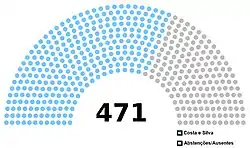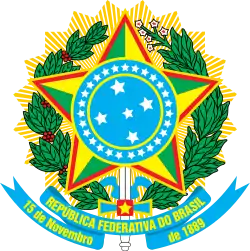1966 Brazilian presidential election
Indirect presidential elections were held in Brazil on 3 October 1966 through an electoral college system. It was the second election during the Brazilian military government, with Artur da Costa e Silva as the sole candidate. Costa e Silva was elected with 295 votes from the ruling National Renewal Alliance Party (ARENA).[1]
| ||||||||||||||||||||||
471 members of the electoral college 236 electoral votes needed to win | ||||||||||||||||||||||
|---|---|---|---|---|---|---|---|---|---|---|---|---|---|---|---|---|---|---|---|---|---|---|
| ||||||||||||||||||||||
 Map of votes in the electoral college | ||||||||||||||||||||||
| ||||||||||||||||||||||
 |
|---|
| This article is part of a series on the politics and government of Brazil |
|
|
Background
During the rule of Castelo Branco, several Institutional Acts were amended, increasing the power of military regime.[2] The elections scheduled for 1965 were delayed to 1966.
The elections were the first after various changes in domestic politics. Following various cessations of political rights, Juscelino Kubitschek, Adhemar de Barros, Carlos Lacerda and Jânio Quadros, the main political leaders, were deposed after allegations of conspiracy and corruption. Once again, the National Congress of Brazil elected the president. The vice-presidential candidacy was linked with the candidacy of the presidency. Only two political parties were legal at the time. However, the opposition party did not put forward a candidate.[3]
Results
| Candidate | Party | Running mate | Party | Votes | % | |
|---|---|---|---|---|---|---|
| Artur da Costa e Silva | ARENA | Pedro Aleixo | ARENA | 294 | 100 | |
| Abstentions | 41 | − | ||||
| Total | 335 | 100 | ||||
| Absences | 136 | 28.88 | ||||
| Registered voters/turnout | 471 | 71.12 | ||||
References
- "Costa e Silva já está eleito" [Costa e Silva already elected]. Folha de S.Paulo (in Portuguese). São Paulo. Folha. 4 October 1966. p. 1.
- https://super.abril.com.br/especiais/21-mitos-sobre-a-ditadura-militar/
- https://www.infoescola.com/historia/alianca-renovadora-nacional-arena/
.jpg.webp)